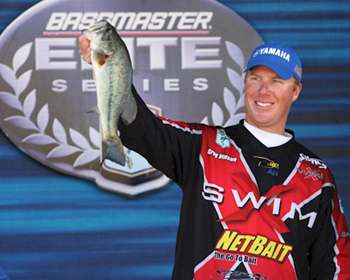
It's a tournament fisherman's worst nightmare: You've found fish during practice up in the shallows, only to return the next day to realize the water has dropped overnight. Many times, that scenario leads to much head scratching and frustration.
Elite Series pro Greg Vinson explains that, in reality, the shallow fish you'd found are still nearby — only repositioned. "More often than not, when the water begins to drop, your most productive areas are going to be those with deeper water close by," he says. "It's probably the most difficult situation to encounter if you've found fish on a big flat because those fish just seem to disappear."
When the bottom drops out of the lake overnight, fishing can be extremely tough the following day; however, as Vinson explains, if it occurs during your fishing day, it can liven things up. "It seems like if it happens during the day, they might bite a little better because of the current," he says. "It's when you've had an overnight drop that they really get tight-lipped and won't bite." As the water falls, bass will retreat to the next available cover.
"Bass will tend to gravitate to areas that have deeper water real close," he points out. "Fast-falling water will actually tend to concentrate fish that have been up shallow right along that first deep break." How far a bass will migrate during falling water is, as Vinson explains, specific to the body of water you're fishing. "For instance, at Dardanelle this year I was fishing a flat that was over a mile wide. Those fish had to move a long ways when the water started coming down in order to get to the first channel swing adjacent to the flat, which is usually where you can expect to find them." For shallow-water fisheries, such as Dardanelle, bass may move hundreds of yards.
On the other hand, Vinson points out that on deeper-water impoundments, the move might be only a short distance. "On the Coosa River chain, those fish won't move as far because of the abundance of deep water," he says. "A lot of times, you'll see that they've pulled out to boat docks that are sitting right on the edge of the deep water drop." Regardless of the body of water, Vinson will first target the secondary areas — channel swings or breaklines — with the same presentation he'd been using prior to the water's drop.
"I like to focus on isolated wood along that first channel swing or deep break," he says. "I'll use a variety of baits — like a jig, or even a crankbait — to cover water. I won't usually change my presentation, but the most important thing is to find shallow-water cover with deep water nearby." Vinson points out that if you're not getting bit on the secondary areas, it's time to move even further out. "A lot of times fish will completely pull out of an area," he says. "They might go to the first point, or maybe even a hump that's further out than that. If they seemed to have bypassed those secondary areas, then that's where they're headed."
The bottom line for Vinson is that if you've found fish up shallow, regardless of falling water, they're still going to be in the same general area. The trick is to narrow the possibilities. "I'm not going to give up on an area just because the water has dropped," he says. "I'm going to check on those secondary areas adjacent to deeper water. Chances are that I'll find them there."




